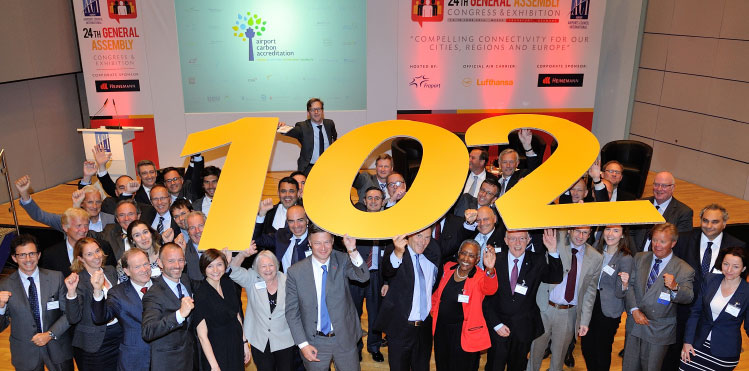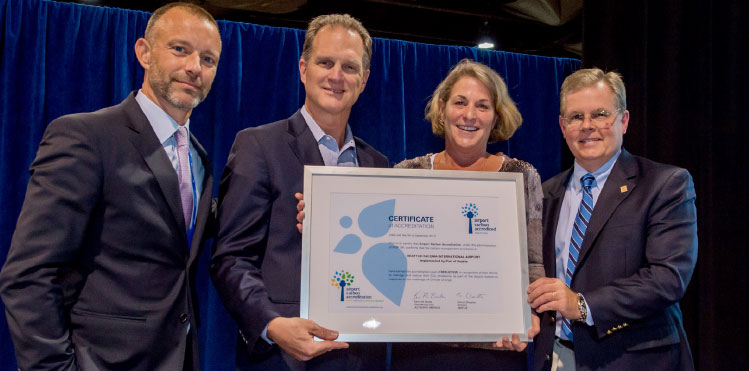
In June 2014, Airport Carbon Accreditation celebrated five years, at the 24th ACI EUROPE Annual Congress in Frankfurt, with a total of 102 airports in Europe, Africa and Asia-Pacific certified at that moment.
On 23 September the UNFCCC held a special UN Climate Summit in New York, featuring a host of famous faces and political heavyweights. The weekend that preceded it saw nearly 400,000 people take to the streets of New York, to raise awareness about the need for action on Climate Change. Renowned author and social activist Naomi Klein has just released a new book about the impact of Climate Change and a plethora of documentaries are due for release in the next 18 months. And here in Europe, the EU is about to welcome a brand new EU Commissioner for Climate Action for the next five years. Make no mistake, Climate Change is back on the political agenda.
Aviation, with its aspirational sheen and its unparalleled visibility, is all too often a target of heavy criticism from environmental groups and regulators, but this disregards so much of the work that is going on behind the scenes. While manufacturers have been busy developing more fuel-efficient aircraft, airlines have been testing biofuels and governments have been negotiating a global emissions trading scheme, what’s been going on at airports?
Airports, as the ambassadors of aviation on the ground, have been hard at work, mapping and reducing their carbon emissions, engaging onsite partners to do the same and in some cases, even going all the way to carbon neutrality.
A programme of great success
This all goes back to a promise made in 2008, when European airports committed to reduce their carbon emissions, with the ultimate goal of becoming carbon neutral. One year on, at the ACI EUROPE Annual Congress in June 2009, Airport Carbon Accreditation, the institutionally endorsed environmental programme, was launched by ACI EUROPE. It has proved to be the lightning rod for so much of the work that airports are doing to address the issue of Climate Change.
The success is reflected in extraordinary figures. In June of this year, the programme celebrated five years, at the 24th ACI EUROPE Annual Congress in Frankfurt, with a total of 102 airports in Europe, Africa and Asia-Pacific certified at that moment. On this occasion, it was also announced that this past year alone European airports in the programme achieved a net reduction of 353,842 tonnes of CO2, enough to power 147,781 households for a year. In other words, there was an average 5.98% reduction across all the European airports certified by the programme.
Three months later (that is, currently), 108 airports are certified in five continents, welcoming 24.2% of global passenger traffic annually. 17 of those airports are carbon neutral, including Stockholm-Arlanda, Oslo, Ankara and Amsterdam Airport Schiphol. This is clear evidence that the programme is managing to achieve its main goal: helping the airport industry reduce its carbon emissions with the ultimate goal of becoming carbon neutral.
108 certified airports is a remarkable achievement, not only because the figure itself (and its relevance in terms of global passenger traffic, as indicated above) is impressive, but also because it reflects the extension of the programme to airports in a new region within the programme: North America.
Lift-off in North America

In September, at the 2014 Annual Conference & Exhibition of ACI-North America, Airport Carbon Accreditation launched in North America, with Seattle-Tacoma International Airport the first North American airport achieving Level 2 Reduction. Pictured are: Olivier Jankovec, Director General, ACI EUROPE; Mark Reis, Managing Director, Seattle-Tacoma International Airport and 2014 ACI-North America Board Chairman; Elizabeth Leavitt, Director, Aviation Planning & Environment, Seattle-Tacoma International Airport; and Kevin Burke, President & CEO, ACI-North America.
In September, at the 2014 Annual Conference & Exhibition of ACI-North America, Airport Carbon Accreditation launched in North America, marking a decisive step in consolidating the programme as the global standard for carbon management at airports. Kevin M. Burke, President & CEO of ACI-North America, stated that this extension showed that “our airport industry has become more demanding of itself. The success of the programme in other parts of the world is both an inspiration and a challenge.”
Simultaneously, the announcement that Seattle-Tacoma International Airport was the first North American airport achieving Level 2 Reduction has opened a foreseeably successful chapter in the North American airport industry history with respect to its environmental strategy. It is already inspiring other North American airports (Aéroports de Montréal, Denver International Airport, San Francisco International Airport and Portland International Airport) to follow its example.
Back to the origins
It all started in 2009. Following an industry commitment to address its CO2 emissions, ACI EUROPE decided to launch Airport Carbon Accreditation at its 19th Annual Congress, where over 30 airports committed to becoming accredited within the first year.
In September 2009, Frankfurt Airport became the very first accredited airport achieving Level 2 Reduction, and in November 2009 Stockholm-Arlanda Airport became the first airport to achieve the highest level of accreditation: Level 3+ Neutrality.
Subsequently, more and more airports joined the programme and new milestones were gradually reached: in November 2011, Airport Carbon Accreditation took flight in Asia-Pacific (in association with ACI Asia-Pacific), where a total of 20 airports are now certified; in June 2013, it was extended to Africa, in partnership with ACI Africa, where Enfidha-Hammamet International Airport, the first African airport certified by the programme, has upgraded to Level 2 Reduction.
More recently, in November 2013, Airport Carbon Accreditation was named one of the top three low carbon projects for Europe in the European Commission’s World You Like Contest, and earlier this year was highly commended at the International Transport Forum’s Transport Achievement Awards.
How Airport Carbon Accreditation works
Airport Carbon Accreditation is a voluntary programme that works on an annual basis. Airports applying to become Airport Carbon Accredited at one of the four available levels of certification (Mapping, Reduction, Optimisation and Neutrality) must have their application verified by an independent third party and then fully reviewed by the programme administrator.
Airport Carbon Accreditation is administered by WSP Group, an international consultancy appointed to enforce the programme’s strict certification criteria. The programme is also overseen by an independent Advisory Board including representatives from ICAO (International Civil Aviation Organisation), UNEP (United Nations Environmental Programme), the European Commission, ECAC (European Civil Aviation Conference), EUROCONTROL and Manchester Metropolitan University.
Airports are managing to continuously address their carbon footprint in a variety of ways. These include: investments in heating and lighting efficiency technology, electric, hybrid or gas-powered vehicles and public transport incentive schemes. Airports implementing programmes such as Airport Collaborative Decision Making (A-CDM) and Continuous Descent Operations (CDO) also help engage others to lower their emissions on the airport site.
How to become Airport Carbon Accredited
Airports interested in Airport Carbon Accreditation, can start the process by using the online application tool, available on the website:
www.airportcarbonaccredited.org
Back to the bigger picture
Airports’ work on Climate Change is ongoing and there will be more to report on Airport Carbon Accreditation in the coming months, but also we’ll have new information on measures being undertaken to prepare airports for the impact that Climate Change will have on their own operations. Watch this space.







